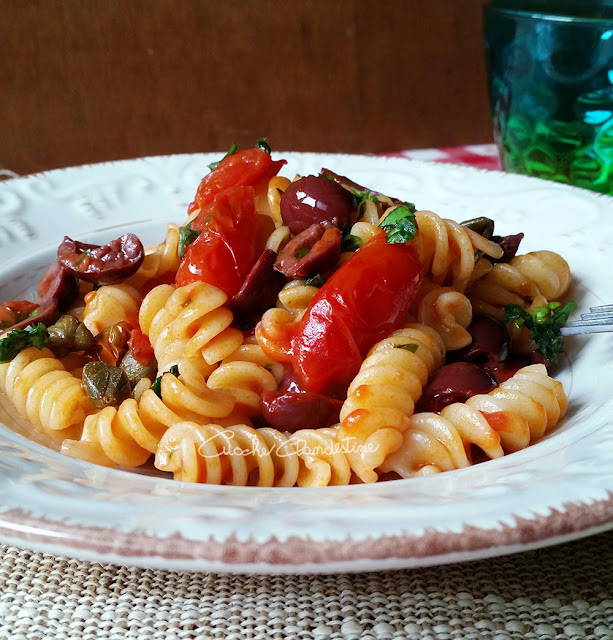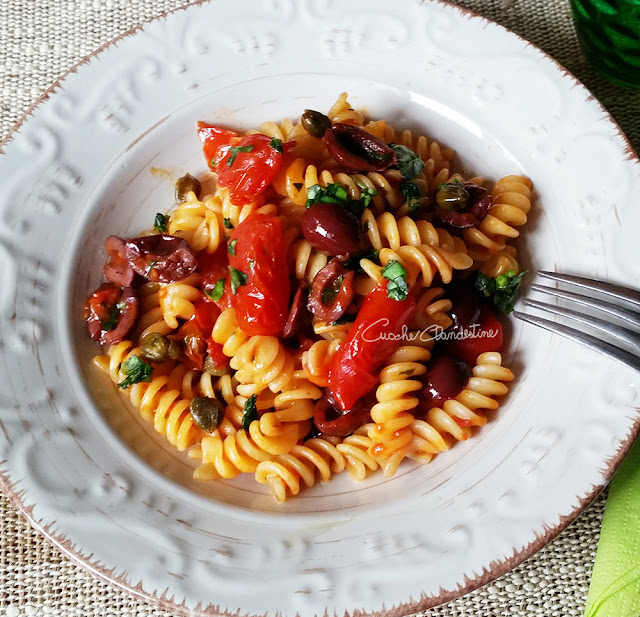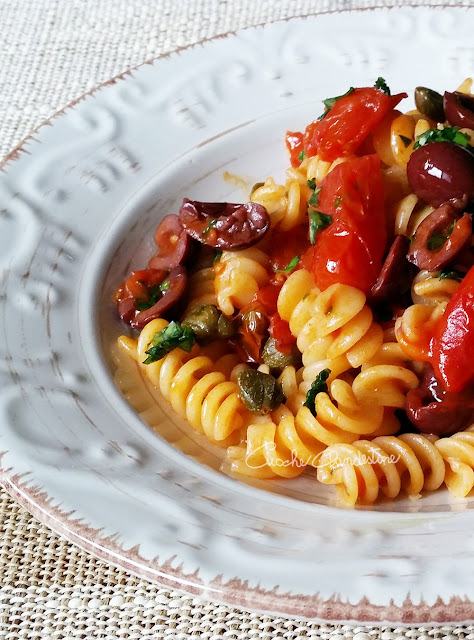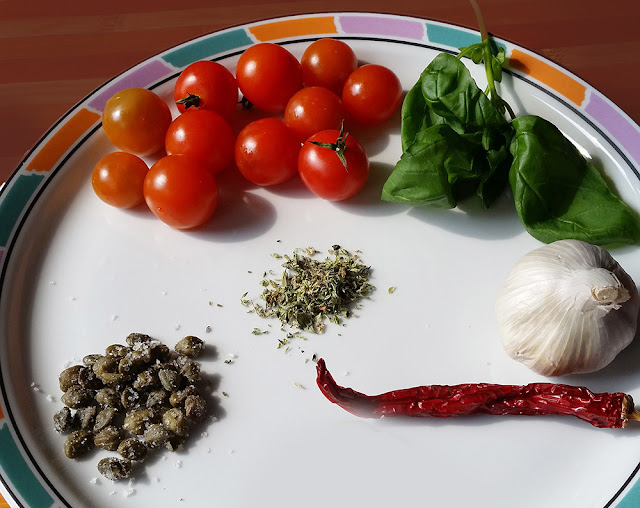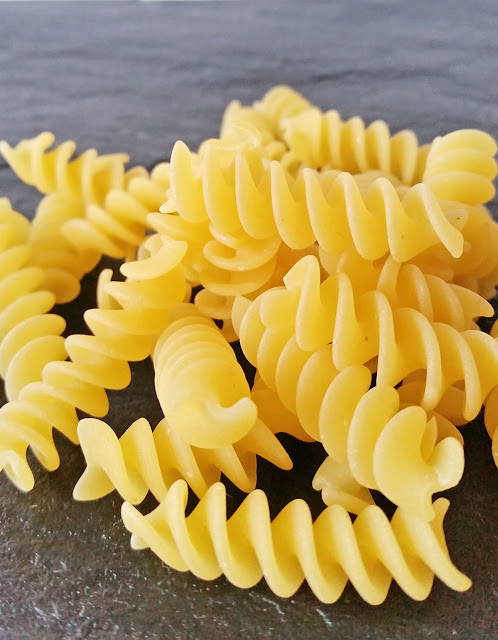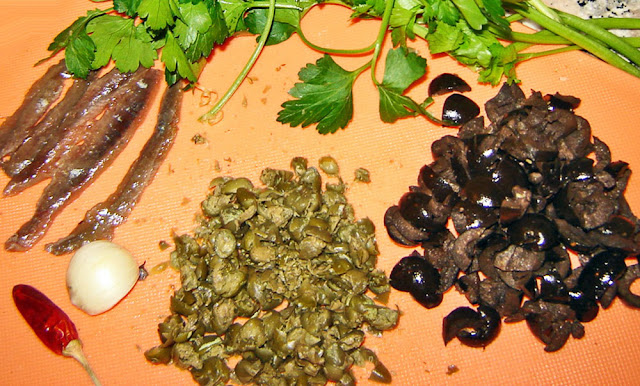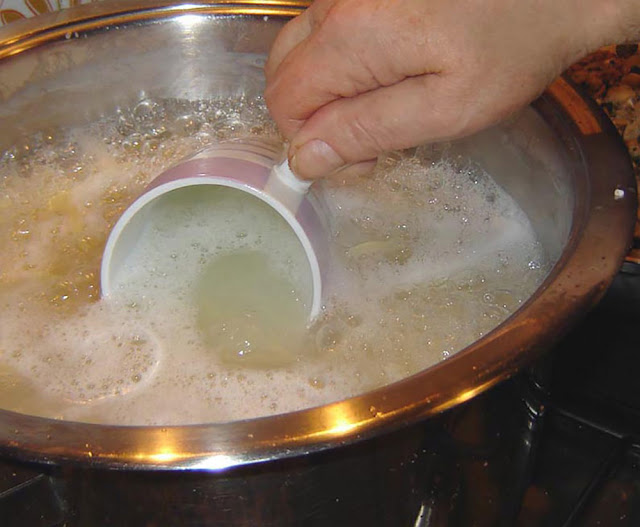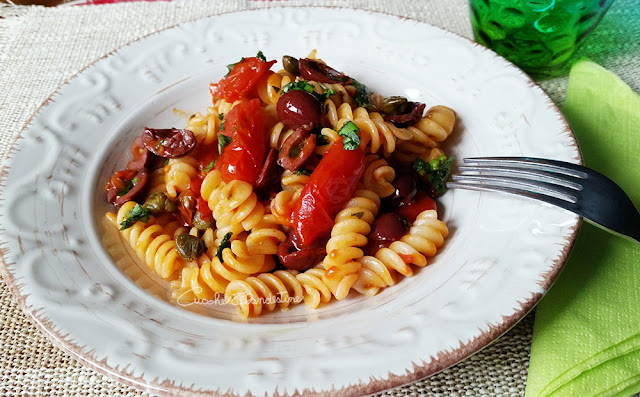Español. Salsa alla “puttanesca”. Desde donde nase ese nombre no es tan clara. Lo que es seguro es que una de las mejores salsas que recogen los sabores del Mediterráneo y sobre todo, se hacen en un momento.
Source: “La cucina napoletana” – Jeanne Caròla Francesconi, Newton Compton Ed. Italy
Español. Hicimos un poco de investigación para saber de donde naciò èste nombre tan curioso (puttanesca) y merece ser explicado. Bueno, parece que el padrino de este plato es el pintor Eduardo Colucci quien bautizó la ”pasta alla puttanesca“ en 1950. *
Nadie sabe qué significado tenía para él, pero sin duda hay que era la isla de Ischia cuando lo inventó y por eso la pasta puttanesca está vinculada a la tradición napolitana.
* Fuente: ”La cocina napolitana” - Jeanne Caròla Francesconi, Newton Compton Ed Italia.
Español. Pocos ingredientes, que fácilmente muchos tienen en su despensa, un plato que se puede poner a la mesa con mucha facilidad y en poco tiempo: los tomates, las anchoas en aceite, aceitunas, alcaparras, pimiento rojo, ajo, perejil (nosotras hemos puesto una buen puñado de albahaca). Una explosión de sabores.
- 300 g fusilli pasta – 300 g de pasta fusilli
- 4 anchovies preserved in oil – 4 anchoas en aceìte
- 150 g black olives, pitted – 150 g de aceitunas negras deshuesadas
- 2 tablespoons salted capers – 2 cucharadas de alcaparras salados
- 4 ripe tomatoes or 10 cherry tomatoes – 4 tomates grandes o 10 tomates cherry
- 2 cloves of garlic – 2 dientes de ajo
- extra virgin olive oil, sea salt, hot chilli pepper to taste – aceìte de oliva virgen extra, sal, ajì picante segùn el proprio gusto.
- handful of chopped fresh parsley and basil – un puñado de albahaca o perejil fresco picado.
Dificultad: facil – Tiempo: 20 minutos
Bring 4,5 liters of water to a boil, add 30 g of sea salt (1 and a half tablespoon).) Meanwhile, place two cups of water into a saucepan and bring to a boil. Soak the tomatoes into the boiling water for three minutes and remove. Peel and dice the tomatoes.
Español. Cómo pasta elegimos los fusilli, pero también se pueden usar los rigatoni u otra pasta larga, como los espaguetis. Pongan a hervir en una olla 4 litros y medio de agua y añadir aproximadamente 30 g de sal (una cucharada y media). Mientras tanto llevar a ebullición en otra cacerola dos tazas de agua, sumergir los tomates durante tres minutos y luego pelar y cortar en tiras.
Español. Lavar las alcaparras para que pierdan la sal, a continuación, cortar en trozos grandes. Picar las aceitunas y las hierbas de oloe, poniendo a un lado. A continuación, poner 4 cucharadas de aceite de oliva en una cacerola grande a fuego lento. Calentar en el aceite el ajo, el ajì y las anchoas hasta que se disuelven. Añadir las aceitunas, las alcaparras y los tomates, todo picado. Cocinen por 5 minutos a fuego medio.
English. Cook pasta until al dente then drain, but first keep a cup of cooking water aside. Reading Italian recipes you will often meet: “stir-fry pasta adding cooking water” (acqua di cottura). This means that you have to preserve a cup of the water the pasta cooks in, before draining it. When you use this trick you do not need to add cream or oil to your dish: in fact, stir-frying with pasta cooking water will give the pasta a bright, mouth-watering look and a creamy taste. Add water a bit at a time, not too much: the more pasta you have to stir-fry, the more boiling water you will need. Stop when you get a creamy consistency. Stir-fry for two-three minutes only: while in the pot, the pasta will keep cooking and stir-frying it too long will overcook it.
Español. Cuando la pasta estè al dente, listo para escurrir, tomar una taza de agua de la cocción y mantener a un lado. En muchas recetas italianas se recomienda esta práctica. Este es un truco para hacer muchos platos más apetitosos, especialmente aquellos que no tienen tantas salsas líquidas: saltear la pasta en la salsa con el agua de cocción, entonces con su propio almidón, dará un aspecto más brillante a la preparaciòn y se formará una una especie de deliciosa salsa cremosa sin añadir partes de grasa.
Añadir un poco de agua a la vez, salteando la pasta dos o tres minutos hasta cuando se vea una salsita cremosa. Tenga cuidado de no quemar la pasta.
Español. Escurrir la pasta y echarla en la sartén junto con la salsa puttanesca a fuego alto durante unos minutos, añadir un poco de aceite de oliva y un poco de agua de cocciòn. Apagar el fuego, añadir las hierbas de olor picadas y todavìa un poco de aceite y servir. Buen provecho!

